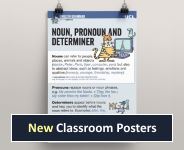Topic: Phrase
These resources look at how words group together into regular units called phrases. Each type of phrase is organised around a particular type of Head word; for example, the Head of a noun phrase is a noun.
Englicious contains many resources for English language in schools, but the vast majority of them require you to register and log in first. For more information, see What is Englicious?

